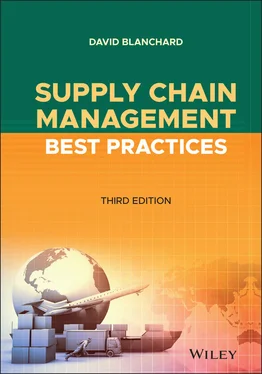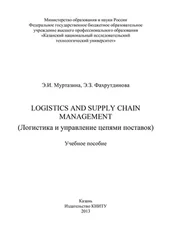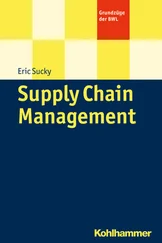18 18 www.3m.com.
19 19Mike Griswold, Dana Stiffler, Stephen Meyer, et al., “The Gartner Supply Chain Top 25 for 2020,” Gartner (May 2020), www.gartner.com.
20 20“Shell: Achieving a Step Change in Logistics Performance through the Design and Deployment of a First-in-Industry 4PL Logistics Solution,” Accenture (2015), www.accenture.com.
21 21 www.e2open.com.
22 22Steven Norton, “Shell Announces Plans to Deploy AI Applications at Scale,” The Wall Street Journal (20 September 2018), www.wsj.com.
23 23David Blanchard, “The Healing Power of the IoT,” IndustryWeek (September/October 2016), 26–28.
24 24 www.jnj.com.
25 25David Blanchard, “Top 25 Supply Chains of 2018,” Material Handling & Logistics (25 June 2018), www.mhlnews.com.
26 26David Blanchard, “Mentoring and Technology Offer a Healthy Outlook for J&J,” IndustryWeek (2 January 2017), www.industryweek.com.
27 27Lauren Thomas and Courtney Reagan, “Watch Out, Retailers. This Is Just How Big Amazon Is Becoming,” CNBC (13 July 2018), www.cnbc.com.
28 28David Blanchard, “The Shape of Logistics Things to Come,” Material Handling & Logistics (September 2017), 12–19.
CHAPTER 3 Supply Chain Metrics: Measuring Up to High Standards
Flashpoints
Statistics are a vital part of managing a supply chain.
The smarter you are at measuring performance metrics, the better your supply chain will run.
Benchmarking lets you know exactly how good (or bad) your company is doing.
Keeping a supply chain scorecard will help you set and achieve attainable targets.
It's probably just a coincidence, but the rise in popularity of supply chain management occurred at the same time as the emergence of sabermetrics . No, you're not going to find that term defined in any business management journal; sabermetrics is the application of statistical analysis and research to the game of baseball. When personal computers became affordable in the early 1980s, supply chain analysts and sabermetricians alike fell in love with databases and spreadsheets that could crunch months' worth of product forecasts and decades' worth of box scores in minutes, rather than days. These days, “keeping a scorecard” is as much a part of the supply chain language as it is sports talk.
To paraphrase John Thorn, coeditor of Total Baseball , statistics are not just a cold-blooded means of dissecting profit-and-loss reports in order to examine a company's performance; rather, statistics are a vital part of the supply chain. The supply chain may be appreciated without statistics, but it cannot be understood without them. 1
To continue the sports analogy, in the fall of 2018, the only event in which cosmetics manufacturer Coty seemed to be excelling was poor planning. Camillo Pane, Coty's CEO, had to explain why various supply chain disruptions cost the company $60 million in its latest quarterly report. Much like a beleaguered baseball manager explains away a loss by pointing to the team's failure to execute on a late-inning play at home plate, so too did Coty find a convenient scapegoat: He blamed it on the supply chain. 2
Specifically, Pane singled out the problems Coty had in realigning its distribution centers in the United States and Europe after acquiring several dozen brands from Procter & Gamble. He also cited unanticipated product shortages at key suppliers. He even resorted to the time-tested standby of blaming the weather—specifically, on production interruptions resulting from Hurricane Florence. The distribution centers couldn't match the pace of the orders coming in. Pane didn't dwell on his role in acquiring the P&G product lines or approving the go-live dates of the distribution centers, much as a baseball manager tends to gloss over whether he rushed a player to the big leagues before he was ready, but within a week of announcing the supply chain disruptions Pane resigned.
Simply put, Coty was having major league problems fulfilling its orders. And Wall Street responded promptly, as Coty's share price dropped 22% when the disruptions were announced. 3
How to Prevent a Supply Chain Heart Attack
Now, here's an example of how sabermetrics-style supply chain analysis can frame Coty's problems as part of a trend that goes far beyond the cosmetics industry. Two researchers—Vinod Singhal of the Georgia Institute of Technology and Kevin Hendricks of the University of Western Ontario—looked at more than 800 announcements of supply chain problems from public companies over an eight-year period (1992–1999). 4 These problems included things like inventory write-offs, parts shortages, shipping delays, and the like. The researchers then tracked the price of these companies' stocks one year before and two years after the announcement.
So what happened? After all the numbers were crunched, a clear trend emerged: Companies that experienced supply chain glitches over that time period saw their average operating income drop 107%, return on sales fall 114%, and return on assets decrease by 93%. And that's not all: These companies also typically saw 7% lower sales growth, 11% higher costs, and a 14% increase in inventories. Exacerbating that already dismal situation is the fact that it takes a long time to recover from these disruptions.
“The supply chain disruption lowers the level of operating performance for a company, and then firms continue to perform at that lower level for the next couple of years,” Singhal explains. He says a supply chain disruption can be compared to a heart attack because it cuts off the flow of information and supplies to a company, and it can have long-term—and sometimes fatal—effects on a company's health.
It doesn't really matter which industry the company is in, either, because any company reporting a supply chain glitch will see its shareholder value plummet. Process manufacturers (e.g., chemicals, food and beverage, textiles) tend to suffer the biggest hit to shareholder return, with a 51% drop. Retailers experience an average decrease of 42%, while high-tech manufacturers will see a 27% decline. Smaller companies are usually hit harder than large ones, although the drop in income is enormous for any size company—150% for small companies, 86% for large.
“When people talk about supply chain management, they may agree that it's important, but they're not investing in solutions,” Singhal points out. However, even when companies do spend on solutions, they're not necessarily spending wisely. “One reason supply chain problems occur is because there isn't enough slack in the system,” Singhal notes. “As companies try to make their supply chains more efficient, they take away slack because it's expensive.”
The answer, though, isn't to throw a lot of money at your supply chain problems. It's to get smarter at identifying and tracking key performance indicators that might signal potential glitches early on. That means developing better forecasts and plans, collaborating with suppliers and customers, ensuring real-time visibility, building flexibility into your supply chain, and other best practices.
It's been said that “the most neglected pathway to increasing shareholder value runs through the supply chain.” In the book The New Supply Chain Agenda , the authors state, “Supply chain excellence drives shareholder value because it controls the heartbeat of the firm—the fundamental flow of materials and information from suppliers through the firm to its customers.” The problem is, there are way too many companies whose supply chains are “crippled by the lack of a strategy, the absence of talent, a misapplication of technology, internal and external silos, and a basic lack of discipline in managing change.” So Coty is hardly alone when it comes to supply chain problems resulting in a severe hit to a company's market value. 5
Читать дальше












